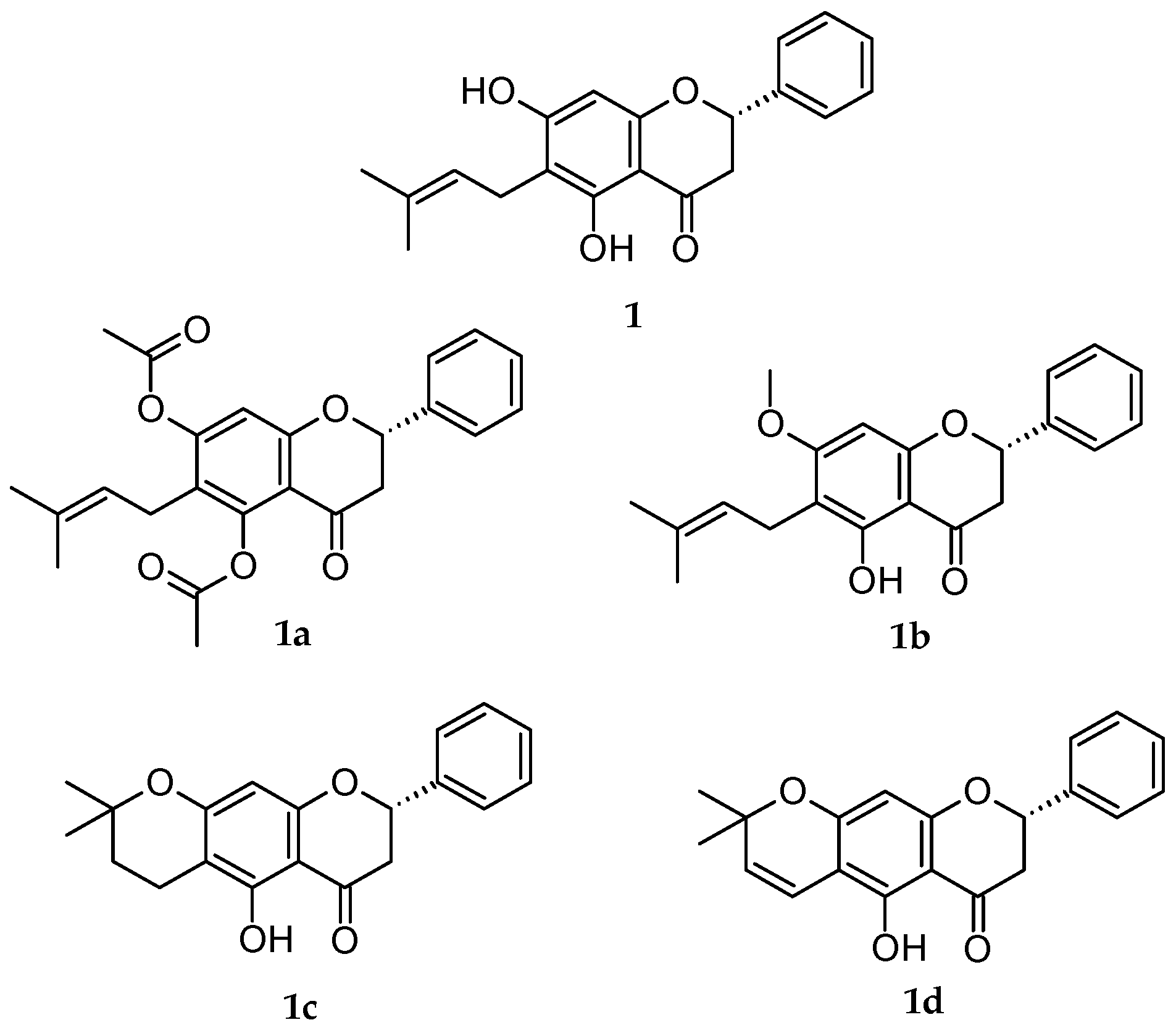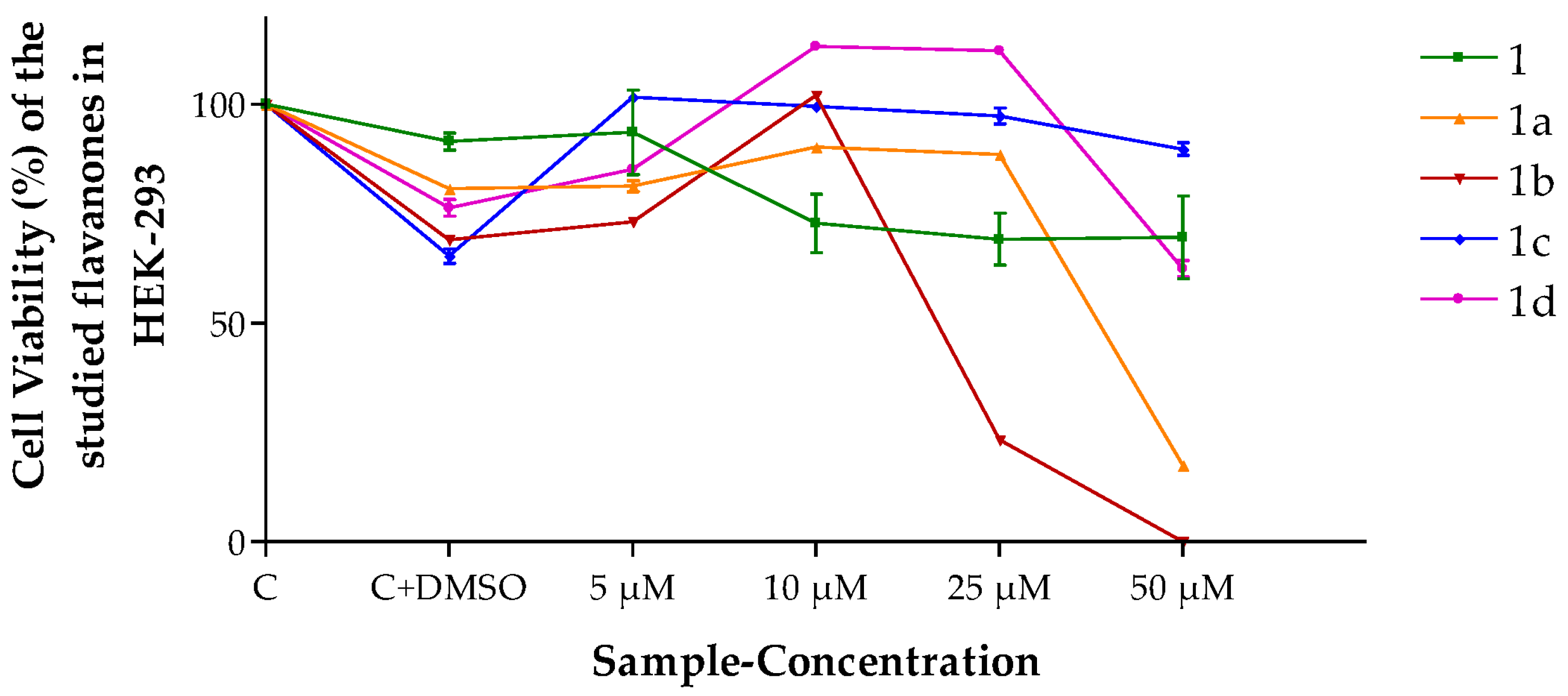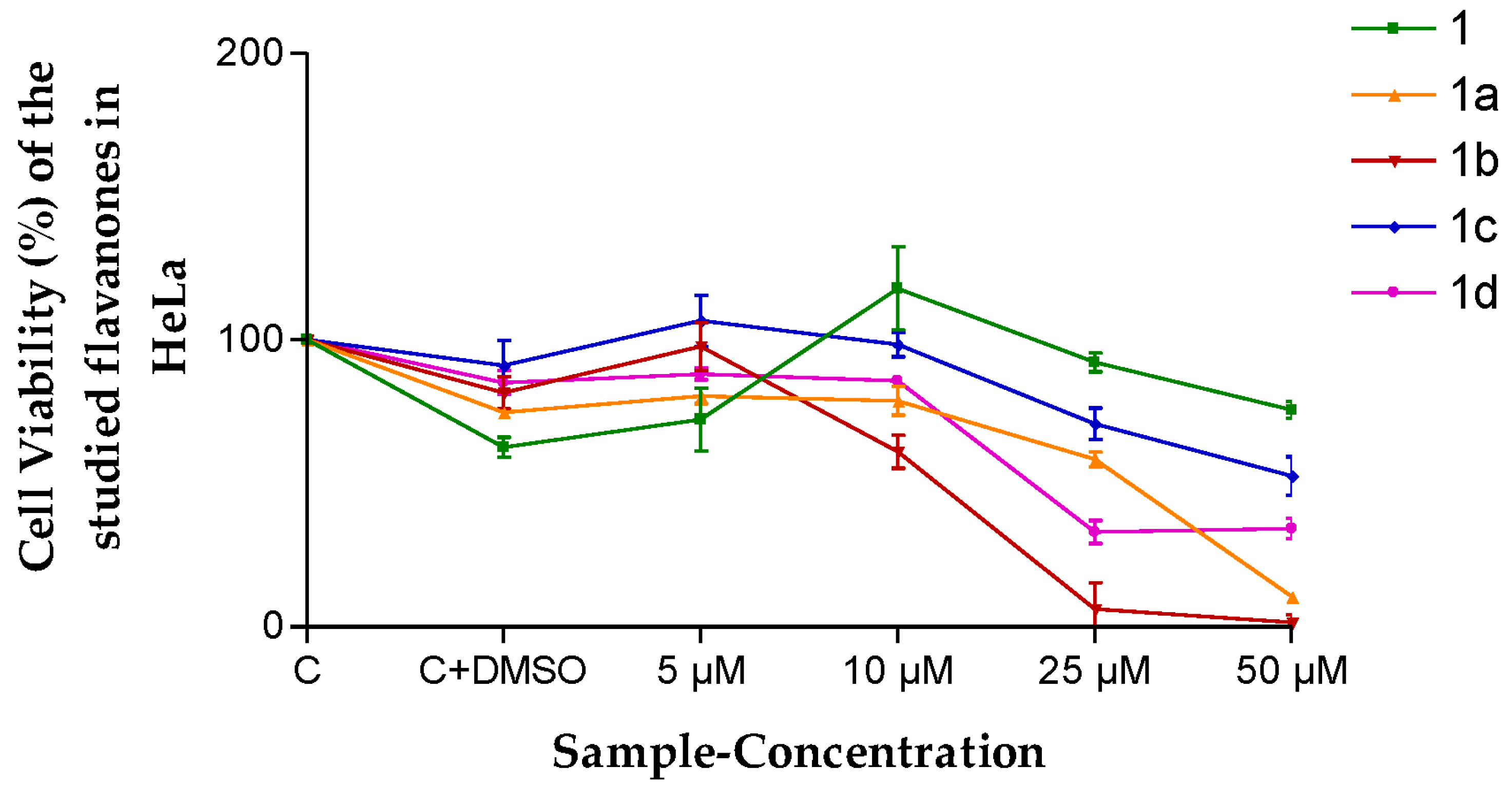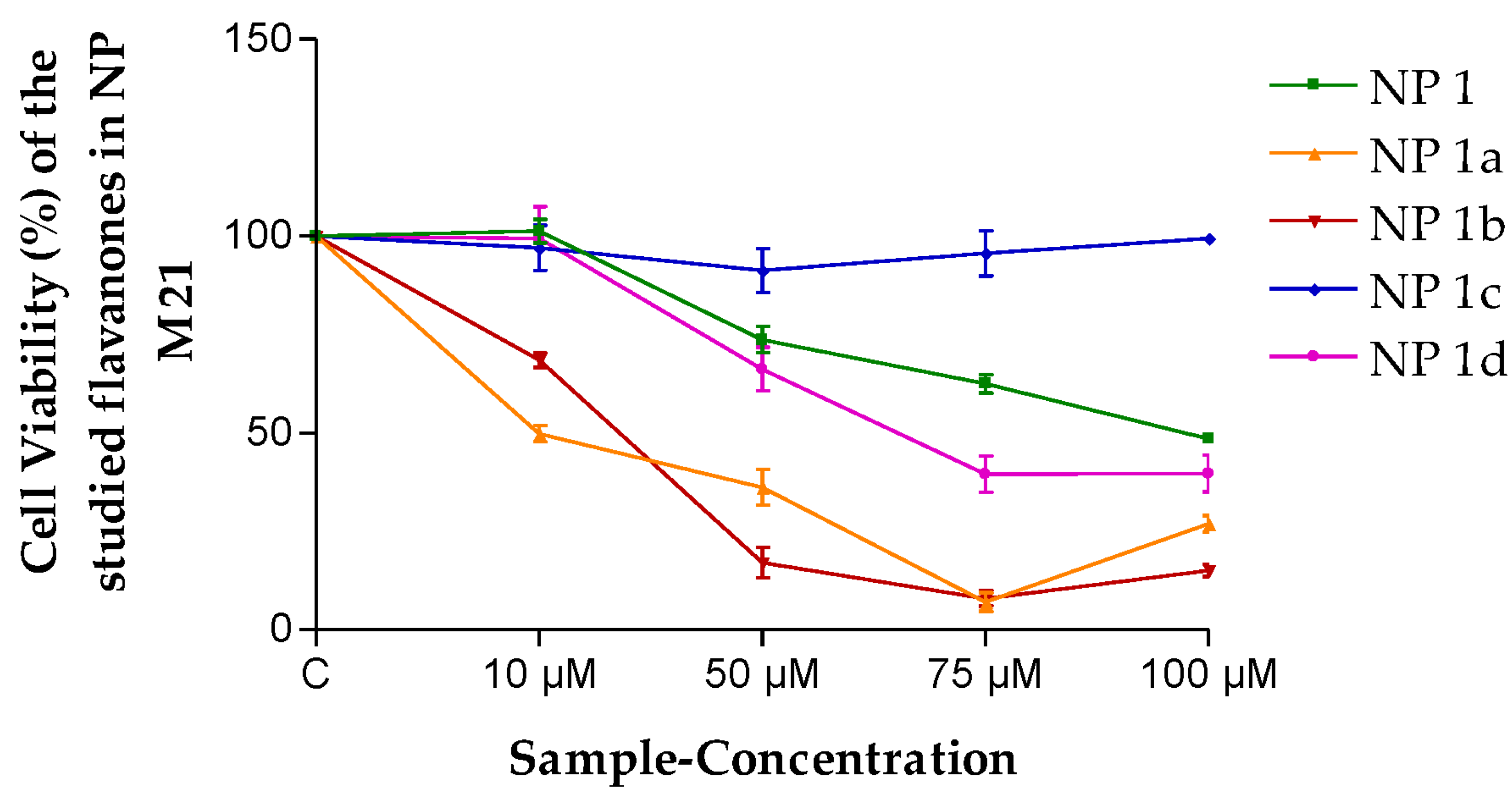In Vitro Approaches to Explore the Anticancer Potential of One Natural Flavanone and Four Derivatives Loaded in Biopolymeric Nanoparticles for Application in Topical Delivery Treatments
Abstract
1. Introduction
2. Materials and Methods
2.1. Chemicals
2.2. In Silico Analyses
2.3. Poly DL-Lactide-Co-Glycolide Acid (PLGA) Nanoparticles (NPs)
2.4. Chromatographic Operating Conditions
2.5. Cytotoxicity Assays: Cell Culture and Cell Viability Assays
2.6. Structure–Activity Relationship Study (SAR)
2.7. Ex Vivo Studies
2.8. Data Analyses
3. Results
3.1. In Silico Analyses
3.2. Cytotoxicity Activity
3.3. Structure–Activity Relationship Study (SAR)
3.4. Ex Vivo Studies
4. Discussion
5. Conclusions
Author Contributions
Funding
Institutional Review Board Statement
Informed Consent Statement
Data Availability Statement
Acknowledgments
Conflicts of Interest
References
- Thring, T.S.; Hili, P.; Naughton, D.P. Antioxidant and potential anti-inflammatory activity of extracts and formulations of white tea, rose, and witch hazel on primary human dermal fibroblast cells. J. Inflamm. 2011, 8, 1–7. [Google Scholar] [CrossRef] [PubMed]
- de Souza, M.L.; Oliveira, D.D.; de Paula Pereira, N.; Soares, D.M. Nanoemulsions and dermatological diseases: Contributions and therapeutic advances. Int. J. Dermatol. 2018, 57, 894–900. [Google Scholar] [CrossRef] [PubMed]
- Dianzani, C.; Zara, G.P.; Maina, G.; Pettazzoni, P.; Pizzimenti, S.; Rossi, F.; Gigliotti, C.L.; Ciamporcero, E.S.; Daga, M.; Barrera, G. Drug delivery nanoparticles in skin cancers. Biomed Res. Int. 2014, 2014, 895986. [Google Scholar] [CrossRef] [PubMed]
- Naves, L.B.; Dhand, C.; Venugopal, J.R.; Rajamani, L.; Ramakrishna, S.; Almeida, L. Nanotechnology for the treatment of melanoma skin cancer. Prog. Biomater. 2017, 6, 13–26. [Google Scholar] [CrossRef]
- Carter, P.; Narasimhan, B.; Wang, Q. Biocompatible nanoparticles and vesicular systems in transdermal drug delivery for various skin diseases. Int. J. Pharm. 2019, 555, 49–62. [Google Scholar] [CrossRef]
- Cullen, J.K.; Simmons, J.L.; Parsons, P.G.; Boyle, G.M. Topical treatments for skin cancer. Adv. Drug Deliv. Rev. 2020, 153, 54–64. [Google Scholar] [CrossRef]
- Khan, T.; Ali, M.; Khan, A.; Nisar, P.; Jan, S.A.; Afridi, S.; Shinwari, Z.K. Anticancer plants: A review of the active phytochemicals, applications in animal models, and regulatory aspects. Biomolecules 2020, 10, 47. [Google Scholar] [CrossRef]
- Wang, X.; Yuan, S.; Wang, J.; Lin, P.; Liu, G.; Lu, Y.; Zhang, J.; Wang, W.; Wei, Y. Anticancer activity of litchi fruit pericarp extract against human breast cancer in vitro and in vivo. Toxicol. Appl. Pharmacol. 2006, 215, 168–178. [Google Scholar] [CrossRef]
- Kowalczyk, T.; Sitarek, P.; Skała, E.; Toma, M.; Wielanek, M.; Pytel, D.; Wieczfińska, J.; Szemraj, J.; Śliwiński, T. Induction of apoptosis by in vitro and in vivo plant extracts derived from Menyanthes trifoliata L. in human cancer cells. Cytotechnology 2019, 71, 165–180. [Google Scholar] [CrossRef]
- Tavsan, Z.; Ayar, H. Flavonoids showed anticancer effects on the ovarian cancer cells: Involvement of reactive oxygen species, apoptosis, cell cycle and invasion. Biomed. Pharmacother. 2019, 116, 109004. [Google Scholar] [CrossRef]
- Bunkar, N.; Shandilya, R.; Bhargava, A.; Samarth, R.M.; Tiwari, R.; Mishra, D.K.; Srivastava, R.K.; Sharma, R.S.; Lohiya, N.K. Nano-engineered flavonoids for cancer protection. Front. Biosci. Landmark 2019, 24, 1097–1157. [Google Scholar]
- Vukovic, N.L.; Obradovic, A.D.; Vukic, M.D.; Jovanovic, D.; Djurdjevic, P.M. Cytotoxic, proapoptotic and antioxidative potential of flavonoids isolated from propolis against colon (HCT-116) and breast (MDA-MB-231) cancer cell lines. Food Res. Int. 2018, 106, 71–80. [Google Scholar] [CrossRef] [PubMed]
- Molcanova, L.; Janosíková, D.; Dall´Acqua, S.; Smejkal, K. C-prenylated flavonoids with potential cytotoxic activity against solid tumor cell lines. Phytochem. Rev. 2019, 18, 1051–1100. [Google Scholar] [CrossRef]
- Gómez-Segura, L.; Parra, A.; Calpena-Campmany, A.C.; Gimeno, Á.; de Aranda, I.G.; Boix-Montañes, A. Ex vivo permeation of carprofen vehiculated by PLGA nanoparticles through porcine mucous membranes and ophthalmic tissues. Nanomaterials 2020, 10, 355. [Google Scholar] [CrossRef] [PubMed]
- Rizk, M.Z.; Abo-el-matty, D.M.; Aly, H.F.; Abd-alla, H.I.; Saleh, S.M.; Younis, E.A.; Elnahrawy, A.M.; Haroun, A.A. Therapeutic activity of sour orange albedo extract and abundant fl avanones loaded silica nanoparticles against acrylamide-induced hepatotoxicity. Toxicol. Rep. 2018, 5, 929–942. [Google Scholar] [CrossRef]
- Kashyap, D.; Singh, H.; Betul, M.; Sharma, A.; Sak, K.; Srivastava, S.; Pandey, A.; Kumar, V.; Sethi, G. Natural product-based nanoformulations for cancer therapy: Opportunities and challenges. Semin. Cancer Biol. 2021, 69, 5–23. [Google Scholar] [CrossRef]
- Krishnan, V.; Mitragotri, S. Nanoparticles for topical drug delivery: Potential for skin cancer treatment. Adv. Drug Deliv. Rev. 2020, 153, 87–108. [Google Scholar] [CrossRef] [PubMed]
- Lu, Z.; Li, P.; Chen, Z.; Zhang, L. Co-encapsulation of combinatorial flavonoids in biodegradable polymeric nanoparticles for improved anti-osteoporotic activity in ovariectomized rats. Environ. Technol. Innov. 2021, 24, 102079. [Google Scholar] [CrossRef]
- Narváez Mastache, J.M.; Garduño-Ramírez, M.L.; Alvarez, L.; Delgado, G. Antihyperglycemic Activity and Chemical Constituents of Eysenhardtia platycarpa. J. Nat. Prod. 2006, 69, 1687–1691. [Google Scholar] [CrossRef]
- Andrade-Carrera, B.; Clares, B.; Noé, V.; Mallandrich, M.; Calpena, A.; García, M.; Garduño-Ramírez, M. Cytotoxic Evaluation of (2S)-5,7-Dihydroxy-6-prenylflavanone Derivatives Loaded PLGA Nanoparticles against MiaPaCa-2 Cells. Molecules 2017, 22, 1553. [Google Scholar] [CrossRef]
- Narváez Mastache, J.M.; Soto, C.; Delgado, G. Antioxidant Evaluation of Eysenhardtia Species (Fabaceae): Relay Synthesis of 3-O-Acetyl-11 a, 12 a -epoxy-oleanan-28, 13 b-olide Isolated from E. platycarpa and Its Protective Effect in Experimental Diabetes. Biol. Pharm. Bull. 2007, 30, 1503–1510. [Google Scholar] [CrossRef] [PubMed]
- Bustos-Salgado, P.; Andrade-Carrera, B.; Domínguez-Villegas, V.; Díaz-Garrido, N.; Rodríguez-Lagunas, M.J.; Badía, J.; Baldomà, L.; Mallandrich, M.; Calpena-Campmany, A.; Garduño-Ramírez, M.L. Screening anti-inflammatory effects of flavanones solutions. Int. J. Mol. Sci. 2021, 22, 8878. [Google Scholar] [CrossRef]
- Garcia-Campoy, A.; Garcia, E.; Muñiz-Ramirez, A. Phytochemical and pharmacological study of the eysenhardtia genus. Plants 2020, 9, 1124. [Google Scholar] [CrossRef]
- Filimonov, D.A.; Lagunin, A.A.; Gloriozova, T.A.; Rudik, A.V.; Druzhilovskii, D.S.; Pogodin, P.V.; Poroikov, V.V. Prediction of the biological activity spectra of organic compounds using the pass online web resource. Chem. Heterocycl. Compd. 2014, 50, 444–457. [Google Scholar] [CrossRef]
- Imran, M.; Aziz, M.; Kumar, N.; Kousar, Z.; Shabnam, S.; Nohri, F. Synthesis, Spectroscopic Characterization and Petra Osiris Molinspiration (POM) Analyses of Dicarboxylic Acid Amides. Int. J. Pharm. Sci. Res. 2016, 7, 1915–1927. [Google Scholar] [CrossRef]
- Daina, A.; Michielin, O.; Zoete, V. SwissTargetPrediction: Updated data and new features for efficient prediction of protein targets of small molecules. Nucleic Acids Res. 2019, 47, W357–W3664. [Google Scholar] [CrossRef]
- Bustos-Salgado, P.; Andrade-Carrera, B.; Domínguez-Villegas, V.; Rodríguez-Lagunas, M.J.; Boix-Montañes, A.; Calpena-Campmany, A.; Garduño-Ramírez, M.L. Biopharmaceutic study and in vivo efficacy of natural and derivatives flavanones formulations. Nanomedicine 2021, 16, 368. [Google Scholar] [CrossRef] [PubMed]
- Bustos-Salgado, P.; Andrade-Carrera, B.; Garduño-Ramírez, M.L.; Alvarado, H.; Calpena-Campmany, A. Quantification of One Prenylated Flavanone from Eysenhardtia platycarpa and Four Derivatives in Ex Vivo Human Skin Permeation Samples Applying a Validated HPLC Method. Biomolecules 2020, 10, 889. [Google Scholar] [CrossRef] [PubMed]
- Green, M.; Kashetsky, N.; Feschuk, A.; Maibach, H.I. Transepidermal water loss (TEWL): Environment and pollution—A systematic review. Ski. Health Dis. 2022, 2, 104. [Google Scholar] [CrossRef]
- Domínguez-Villegas, V.; Clares-Naveros, B.; García-López, M.L.; Calpena-Campmany, A.C.; Bustos-Salgado, P.; Garduño, M.L. Development and Characterization of two Nano-Structured Systems for Topical Application of Flavanones Isolated from Eysenhardtia platycarpa. Colloids Surf. B Biointerfaces 2014, 116, 183–192. [Google Scholar] [CrossRef]
- Anwar, S.S.; Al-Shmgani, H.S.A.; Tawfeeq, A.T.; Sulaiman, G.M.; Al-Mousawi, Y.H. In silico analysis of quercetin as potential anti-cancer agents. Mater. Today Proc. 2021, 42, 2521–2526. [Google Scholar] [CrossRef]
- Kumer, A.; Sarker, M.N.; Paul, S. The theoretical investigation of HOMO, LUMO, thermophysical properties and QSAR study of some aromatic carboxylic acids using HyperChem programming. Int. J. Chem. Technol. 2019, 3, 26–37. [Google Scholar] [CrossRef]
- Kaur, B.; Rolta, R.; Salaria, D.; Kumar, B.; Fadare, O.A.; da Costa, R.A.; Ahmad, A.; Al-Rawi, M.B.A.; Raish, M.; Rather, I.A. An In Silico Investigation to Explore Anti-Cancer Potential of Foeniculum vulgare Mill. Phytoconstituents for the Management of Human Breast Cancer. Molecules 2022, 27, 4077. [Google Scholar] [CrossRef] [PubMed]
- Abkar, A.H.; Djati, M.S. In Silico Study to Predict the Potential of Beta Asarone, Methyl Piperonylketone, Coumaric Acid in Piper Crocatum as Anticancer Agents. J. Exp. Life Sci. 2021, 11, 89–99. [Google Scholar] [CrossRef]
- Kopustinskiene, D.M.; Jakstas, V.; Savickas, A.; Bernatoniene, J. Flavonoids as Anticancer Agents. Nutrients 2020, 12, 457. [Google Scholar] [CrossRef] [PubMed]
- Abotaleb, M.; Samuel, S.M.; Varghese, E.; Varghese, S.; Kubatka, P.; Liskova, A.; Büsselberg, D. Flavonoids in cancer and apoptosis. Cancers 2019, 11, 28. [Google Scholar] [CrossRef]
- Im, N.; Jang, W.J.; Jeong, C.; Jeong, G. Delphinidin Suppresses PMA-Induced MMP-9 Expression by Blocking the NF-j B Activation Through MAPK Signaling Pathways in MCF-7 Human Breast Carcinoma Cells. J. Med. Food 2014, 17, 855–861. [Google Scholar] [CrossRef]
- Chen, L.; Teng, H.; Xie, Z.; Cao, H.; Cheang, W.S.; Skalicka-Woniak, K.; Georgiev, M.I.; Xiao, J. Modifications of dietary flavonoids towards improved bioactivity: An update on structure–activity relationship. Crit. Rev. Food Sci. Nutr. 2018, 58, 513–527. [Google Scholar] [CrossRef]
- Rosa, G.P.; Seca, A.M.L.; Barreto, M.d.C.; Silva, A.M.S.; Pinto, D.C.G.A. Chalcones and flavanones bearing hydroxyl and/or methoxyl groups: Synthesis and biological assessments. Appl. Sci. 2019, 9, 2846. [Google Scholar] [CrossRef]
- Assirey, E.; Alsaggaf, A.; Naqvi, A.; Moussa, Z.; Okasha, R.M.; Afifi, T.H.; Abd-El-Aziz, A.S. Synthesis, biological assessment, and structure activity relationship studies of new flavanones embodying chromene moieties. Molecules 2020, 25, 544. [Google Scholar] [CrossRef]
- Laxmi, D.; Priyadarshy, S.; Rating, O. HyperChem 6.03. Biotech Softw. Internet Rep. 2002, 3, 5–9. [Google Scholar] [CrossRef]
- Jarrahpour, A.; Fathi, J.; Mimouni, M.; Hadda, T.B.; Sheikh, J.; Chohan, Z.; Parvez, A. Petra, Osiris and Molinspiration (POM) together as a successful support in drug design: Antibacterial activity and biopharmaceutical characterization of some azo Schiff bases. Med. Chem. Res. 2012, 21, 1984–1990. [Google Scholar] [CrossRef]
- Khan, H.; Ullah, H.; Martorell, M.; Valdes, S.E.; Belwal, T.; Tejada, S.; Sureda, A.; Kamal, M.A. Flavonoids nanoparticles in cancer: Treatment, prevention and clinical prospects. Semin. Cancer Biol. 2021, 69, 200–211. [Google Scholar] [CrossRef] [PubMed]
- Agarawal, K.; Anant, Y.; Sarika, K. Nanoformulations of flavonoids for diabetes and microvascular diabetic complications. Drug Deliv. Transl. Res. 2022, 13, 18–36. [Google Scholar] [CrossRef]
- Guo, M.; Zhou, G.; Liu, Z.; Liu, J.; Tang, J.; Xiao, Y.; Xu, W.; Liu, Y.; Chen, C. Direct site-specific treatment of skin cancer using doxorubicin-loaded nanofibrous membranes. Sci. Bull. 2018, 63, 92–100. [Google Scholar] [CrossRef] [PubMed]
- Teng, H.; Zheng, Y.; Cao, H.; Huang, Q.; Xiao, J.; Chen, L. Enhancement of bioavailability and bioactivity of diet-derived flavonoids by application of nanotechnology: A review. Crit. Rev. Food Sci. Nutr. 2023, 63, 378–393. [Google Scholar] [CrossRef] [PubMed]
- Maity, S.; Acharyya, A.; Sankar Chakraborti, A. Flavonoid-based polymeric nanoparticles: A promising approach for cancer and diabetes treatment. Eur. Polym. J. 2022, 177, 111455. [Google Scholar] [CrossRef]
- Miralles Cardiel, E.; Silva-Abreu, M.; Calpena, A.C.; Casals, I. Development and Validation of a HPLC–MS/MS method for Pioglitazone from Nanocarriers Quantitation in Ex Vivo and In Vivo Ocular Tissues. Pharmaceutics 2021, 13, 650. [Google Scholar] [CrossRef]
- Pool, H.; Quintanar, D.; Figueroa, J.D.D.; Marinho Mano, C.; Bechara, J.E.H.; Godínez, L.A.; Mendoza, S. Antioxidant effects of quercetin and catechin encapsulated into PLGA nanoparticles. J. Nanomater. 2012, 2012, 145380. [Google Scholar] [CrossRef]






| Nanoparticle | Physicochemical Characteristics | |||
|---|---|---|---|---|
| Z-Average (nm) | PI | Z (mV) | EE (%) | |
| NP 1 | 205.20 ± 0.27 | 0.06 ± 0.05 | −8.25 ± 0.24 | 80.00 ± 4.75 |
| NP 1a | 178.03 ± 1.33 | 0.08 ± 0.004 | −9.05 ± 0.32 | 88.47 ± 4.18 |
| NP 1b | 141.63 ± 0.78 | 0.09 ± 0.02 | −10.63 ± 0.23 | 85.00 ± 5.80 |
| NP 1c | 175.17 ± 0.60 | 0.10 ± 0.03 | −6.48 ± 0.38 | 78.28 ± 5.85 |
| NP 1d | 173.40 ± 1.59 | 0.06 ± 0.01 | −6.65 ± 0.41 | 78.75 ± 4.34 |
| Data | Flavanone | ||||
|---|---|---|---|---|---|
| 1 | 1a | 1b | 1c | 1d | |
| Anticarcinogenic (Pa) | 0.790 | 0.768 | 0.797 | 0.722 | 0.625 |
| Antineoplastic (Pa) | 0.774 | 0.804 | 0.758 | 0.692 | 0.797 |
| MMP-9 | 0.734 | 0.588 | 0.766 | 0.481 | 0.523 |
| Caspase-3 | 0.423 | 0.648 | 0.604 | 0.318 | 0.330 |
| Caspase-8 | 0.256 | 0.297 | 0.279 | ND | 0.259 |
| Telomerase | 0.136 | ND | 0.116 | 0.083 | 0.121 |
| Inteleukine-6 | 0.192 | 0.171 | 0.179 | ND | 0.164 |
| Interleukine-10 | ND | ND | 0.095 | 0.096 | 0.099 |
| Compound | Cell Line | NPs | Cell Line | |||
|---|---|---|---|---|---|---|
| HEK-293 | M21 | HeLa | M21 | HeLa | ||
| IC50 (µM) | IC50 (µM) | |||||
| 1 | 6.59 | 7.37 | 24.05 | NP 1 | 49.72 | 11.19 |
| 1a | 28.1 | 20.88 | 19.53 | NP 1a | 10.28 | 36.73 |
| 1b | 22.10 | 13.29 | 11.14 | NP 1b | 14.28 | 10.89 |
| 1c | 27.21 | 21.18 | 19.09 | NP 1c | NE | NE |
| 1d | 28.28 | 15.77 | 12.81 | NP 1d | 49.71 | 24.84 |
| Physicochemical Properties | Flavanones | ||||
|---|---|---|---|---|---|
| 1 | 1a | 1b | 1c | 1d | |
| Total energy (kcal/mol) | −94,946.90 | −12,2792.00 | −98,527.20 | −94,951.30 | −94,294.20 |
| Binding energy (kcal/mol) | −4809.71 | −5879.46 | −5078.27 | −4814.19 | −4682.68 |
| Heat of formation (kcal/mol) | −111.63 | −170.30 | −105.10 | −116.11 | −88.81 |
| Surface area (A2) | 577.35 | 680.43 | 607.10 | 538.39 | 549.13 |
| Volume (A3) | 959.56 | 1176.83 | 1014.63 | 913.85 | 917.78 |
| Mass (amu) | 324.48 | 408.40 | 338.40 | 324.38 | 322.36 |
| HOMO (eV) | −9.02 | −9.11 | −8.95 | −8.98 | −8.67 |
| LUMO (eV) | −0.56 | −0.65 | −0.50 | −0.40 | −0.54 |
| Log P | 0.70 | 0.26 | 0.73 | 0.05 | −0.07 |
| Dipole moment (µ) | 3.55 | 1.50 | 3.82 | 1.44 | 1.52 |
| Polarizability (α) | 35.81 | 43.32 | 37.64 | 35.22 | 35.03 |
| Molecular Descriptors | Free Flavanones | NPs Flavanones | ||||||
|---|---|---|---|---|---|---|---|---|
| M21 | HeLa | M21 | HeLa | |||||
| r2 | F | r2 | F | r2 | F | r2 | F | |
| ET, EE, EF | 0.99 | 10.98 | 0.94 | 2.57 | 0.99 | 13.09 | 0.97 | 6.07 |
| HOMO, LUMO | 0.26 | 0.07 | 0.18 | 0.03 | 0.39 | 0.18 | 0.62 | 0.64 |
| A, V, MM | 0.58 | 0.17 | 0.85 | 0.84 | 0.94 | 2.52 | 0.99 | 12.71 |
| Log P, α, μ | 0.46 | 0.28 | 0.89 | 1.24 | 0.98 | 6.77 | 0.99 | 36.75 |
| NP 1 * | NP 1a | NP 1b | NP 1c | NP 1d | |
|---|---|---|---|---|---|
| J/sur (μg/h/cm2) | |||||
| 0.35 | 160.98 | 0.03 | 0.54 | 2.37 | |
| (0.53−0.005) | (183.52–138.39) | (0.038–0.022) | (0.61–0.49) | (2.71–2.02) | |
| Qr (g/gskin/cm2) | |||||
| 0.54 | 1.44 | 0.07 | 0.04 | 0.01 | |
| (0.62–0.46) | (1.66–1.22) | (0.08–0.06) | (0.05–0.03) | (0.006–0.004) | |
| Qp (µg) | |||||
| 30.34 | 78.08 | 17.84 | 43.32 | 118.29 | |
| (34.13–26.55) | (90.81–65.35) | (20.29–15.40) | (50.12–36.52) | (132.49–104.10) |
Disclaimer/Publisher’s Note: The statements, opinions and data contained in all publications are solely those of the individual author(s) and contributor(s) and not of MDPI and/or the editor(s). MDPI and/or the editor(s) disclaim responsibility for any injury to people or property resulting from any ideas, methods, instructions or products referred to in the content. |
© 2023 by the authors. Licensee MDPI, Basel, Switzerland. This article is an open access article distributed under the terms and conditions of the Creative Commons Attribution (CC BY) license (https://creativecommons.org/licenses/by/4.0/).
Share and Cite
Bustos-Salgado, P.; Andrade-Carrera, B.; Domínguez-Villegas, V.; Noé, V.; Mallandrich, M.; Colom, H.; Calpena-Campmany, A.; Garduño-Ramírez, M.L. In Vitro Approaches to Explore the Anticancer Potential of One Natural Flavanone and Four Derivatives Loaded in Biopolymeric Nanoparticles for Application in Topical Delivery Treatments. Pharmaceutics 2023, 15, 1632. https://doi.org/10.3390/pharmaceutics15061632
Bustos-Salgado P, Andrade-Carrera B, Domínguez-Villegas V, Noé V, Mallandrich M, Colom H, Calpena-Campmany A, Garduño-Ramírez ML. In Vitro Approaches to Explore the Anticancer Potential of One Natural Flavanone and Four Derivatives Loaded in Biopolymeric Nanoparticles for Application in Topical Delivery Treatments. Pharmaceutics. 2023; 15(6):1632. https://doi.org/10.3390/pharmaceutics15061632
Chicago/Turabian StyleBustos-Salgado, Paola, Berenice Andrade-Carrera, Valeri Domínguez-Villegas, Véronique Noé, Mireia Mallandrich, Helena Colom, Ana Calpena-Campmany, and María Luisa Garduño-Ramírez. 2023. "In Vitro Approaches to Explore the Anticancer Potential of One Natural Flavanone and Four Derivatives Loaded in Biopolymeric Nanoparticles for Application in Topical Delivery Treatments" Pharmaceutics 15, no. 6: 1632. https://doi.org/10.3390/pharmaceutics15061632
APA StyleBustos-Salgado, P., Andrade-Carrera, B., Domínguez-Villegas, V., Noé, V., Mallandrich, M., Colom, H., Calpena-Campmany, A., & Garduño-Ramírez, M. L. (2023). In Vitro Approaches to Explore the Anticancer Potential of One Natural Flavanone and Four Derivatives Loaded in Biopolymeric Nanoparticles for Application in Topical Delivery Treatments. Pharmaceutics, 15(6), 1632. https://doi.org/10.3390/pharmaceutics15061632










